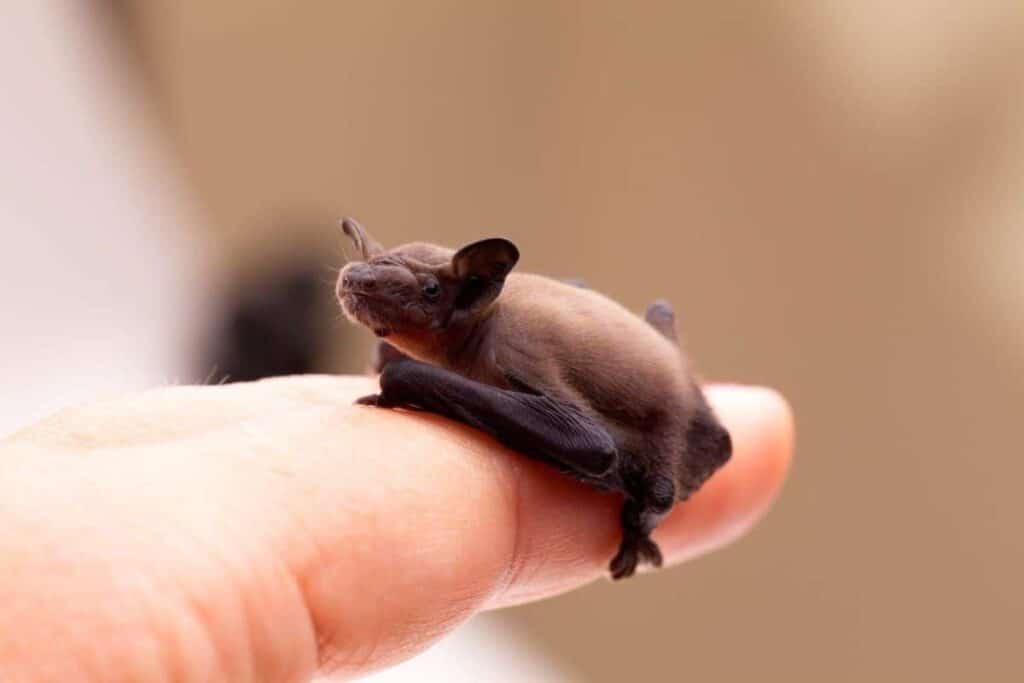Introduction to the Bumblebee Bat
Table of Contents
ToggleThe Bumblebee Bat (Craseonycteris thonglongyai), also part of the bat family, is the world’s smallest bat and one of the tiniest mammals. Weighing less than 2 grams, it’s light as a feather and small enough to fit comfortably on the tip of your finger.
Despite its size, the Bumblebee Bat plays an important role in its ecosystem, making it a fascinating creature for wildlife enthusiasts and conservationists alike.
Native to the forests and caves of Thailand and Myanmar, the Bumblebee Bat was only discovered in 1973, making it a relatively recent addition to the scientific community.
Since then, it has gained attention not only because of its tiny size but also due to its vulnerable status, as human activities threaten its natural habitat.
This little bat may be small, but its significance in the world of bats and mammals is immense, attracting curiosity from researchers and wildlife lovers everywhere.
Physical Characteristics
At first glance, it’s easy to see why this species is named the Bumblebee Bat. These bats are tiny, with a body length of just 29 to 33 mm and a weight ranging between 1.7 and 2 grams about the same as a large bumblebee.
Their reddish-brown or grayish fur helps them blend into the rocky cave environments they call home. One of their most distinct features is their pig-like snout, which has earned them the nickname Kitti’s hog-nosed bat.
This unique nose, combined with their small, round bodies and large ears, gives them a charming yet odd appearance.
Despite their small size, Bumblebee Bats are excellent fliers. Their long, wide wings (with a wingspan of around 5.7 inches) allow them to glide and even hover as they hunt for insects.
They are perfectly adapted for navigating the tight spaces of caves and dense forests. Their tiny size and hovering abilities make them surprisingly agile and efficient when it comes to finding food.
Habitat and Distribution
The Bumblebee Bat has a very limited geographic range, being found only in a few regions of Thailand and Myanmar.
They primarily inhabit limestone caves in tropical forests near rivers, particularly in the Bilauktaung mountain range in western Thailand.
These caves provide the warm, sheltered environment that the bats need to thrive. They typically roost near the ceilings of these caves, where they can stay warm and out of reach of predators.
Unfortunately, their habitats are increasingly threatened by deforestation, limestone quarrying, and tourism.
The extraction of limestone for construction purposes disturbs the caves they rely on for roosting, while deforestation reduces the availability of food sources in the nearby forests.
Additionally, human disturbance through cave tourism can disrupt their roosting patterns, further endangering the population.
Efforts are being made to protect their habitats, but more action is needed to ensure these tiny bats have a future.
Conservationists emphasize the importance of preserving the forests and caves where Bumblebee Bats live, not only to protect this unique species but also to maintain the biodiversity of the region.
Raising awareness about their conservation status is a crucial step in safeguarding their habitat from further destruction.
Diet and Feeding Habits
The Bumblebee Bat is an insectivore, meaning its diet primarily consists of small insects. Despite their tiny size, these bats are efficient hunters, preying on insects such as flies, beetles, moths, and occasionally spiders.
They rely on their ability to fly swiftly and accurately, using echolocation to detect and catch their prey in mid-air. Their echolocation allows them to navigate the dark caves and dense forests where they forage.
What’s fascinating about their foraging behavior is that Bumblebee Bats tend to stay close to home. They typically fly only about 1 kilometer from their cave roosts while hunting for food.
They forage in the upper canopies of forests, where insects are abundant, darting between trees and using their acute senses to pinpoint prey.
Their small size and agility make them well-suited for maneuvering through these tight spaces, allowing them to hover and catch insects with precision.
By feeding on insects, Bumblebee Bats play an essential role in their ecosystem, helping to control insect populations, which can benefit both the forest environment and nearby agricultural areas.
Though small, their contribution to insect control is an important aspect of maintaining ecological balance in the regions they inhabit.
Reproduction and Lifespan
While much of the Bumblebee Bat’s reproductive behavior remains a mystery, we do know that they typically breed once per year, with most births occurring between April and May.
During this period, the female gives birth to a single offspring. Like many other bat species, the young bat stays attached to its mother, clinging to her body while she roosts in the cave.
Newborn Bumblebee Bats are completely dependent on their mothers for care and nourishment. The mother will leave the young in the cave while she forages for food but remains close enough to provide the necessary protection.
Once the young bat matures and can forage on its own, it will leave its mother and begin the cycle of independent life.
The lifespan of Bumblebee Bats is estimated to be around 5 to 10 years, based on studies of related bat species. However, more research is needed to fully understand the factors that influence their survival and longevity in the wild.
The small size of their populations and the pressures on their habitat make it crucial to better understand their life cycle and reproductive habits to ensure their conservation.
Conservation Status and Threats
The Bumblebee Bat is currently listed as Vulnerable on the IUCN Red List, with an estimated global population of only 5,100 individuals.
The population is believed to be declining due to several factors, with habitat destruction being the most significant threat.
Limestone quarrying poses a particular danger, as it destroys the caves where these bats roost, forcing them to relocate or risk losing their homes altogether.
Deforestation also threatens their habitat, as the surrounding forests where they hunt for food are cleared for agriculture and development.
Additionally, cave tourism can disturb their roosting sites, causing the bats to abandon otherwise suitable caves. Human disturbance in these fragile environments disrupts their ability to breed and thrive, further putting pressure on their already small populations.
While some protected areas have been established to help conserve Bumblebee Bat habitats, more action is needed to safeguard these unique creatures.
Stricter regulation of limestone extraction, sustainable tourism practices, and reforestation efforts are critical to preventing further decline in their numbers.
Conservation organizations are working to raise awareness about the Bumblebee Bat’s plight, but continued efforts are necessary to ensure their survival in the wild.
Role in Ecosystem
Bumblebee Bats play a vital role in their ecosystem as insectivores. By feeding on small insects like flies and beetles, they help control insect populations in the areas they inhabit.
This natural form of pest control is particularly beneficial to the surrounding tropical forests, as it helps maintain the balance between different species within the ecosystem.
Though their overall impact may seem small due to their low population numbers, their role is still crucial in preventing the overpopulation of insects that could otherwise affect the health of plants and other wildlife.
Even though they are tiny, Bumblebee Bats contribute to maintaining ecological balance in their native forests.
Their presence indicates a healthy, functioning ecosystem, and protecting their habitats is essential not only for their survival but for the well-being of the broader environment in which they live.
Supporting their conservation is a step toward safeguarding the intricate web of life that thrives in tropical forests.
Myths and Cultural Significance
Despite their remarkable traits, Bumblebee Bats are not widely recognized in popular culture. Their tiny size and unusual appearance have drawn attention from scientists and wildlife enthusiasts, but for many people, bats in general are misunderstood.
In some cultures, bats are associated with fear or negative myths, often seen as pests or creatures of the night.
These misconceptions can lead to fear or avoidance, and in extreme cases, they contribute to unnecessary harm to bat populations.
However, educating people about the ecological importance of bats like the Bumblebee Bat can help dispel these myths.
By highlighting their role in pest control and maintaining biodiversity, we can shift the narrative around bats from fear to appreciation.
Raising awareness about the value of these small, yet significant creatures is key to ensuring their protection and encouraging more people to support conservation efforts.
Conclusion
The Bumblebee Bat is an extraordinary species, not only for its tiny size but also for its important role in the ecosystems of Thailand and Myanmar.
Its unique physical traits, insectivorous diet, and contribution to the ecological balance make it a species worth protecting.
However, their population is declining due to habitat destruction caused by deforestation, limestone quarrying, and human disturbance in the caves where they roost.
Conservation efforts are vital to preserving the future of Bumblebee Bats and ensuring that their habitats remain intact. By supporting conservation initiatives and spreading awareness about the threats they face, we can help protect these incredible creatures.
It’s crucial to take action now, so the Bumblebee Bat can continue playing its important role in maintaining the balance of tropical ecosystems for generations to come.
Frequently Asked Questions
Why is the Bumblebee Bat called that?
The Bumblebee Bat is named for its tiny size, comparable to a large bumblebee, weighing less than 2 grams.
Where do Bumblebee Bats live?
Bumblebee Bats are found in limestone caves in the tropical forests of Thailand and Myanmar, near rivers and forests.
What do Bumblebee Bats eat?
They are insectivores, feeding on small insects like flies, beetles, and moths, using echolocation to catch prey.
Why are Bumblebee Bats endangered?
Their populations are declining due to habitat destruction, such as limestone quarrying, deforestation, and disturbances from tourism.
How long do Bumblebee Bats live?
Bumblebee Bats are estimated to live around 5 to 10 years, similar to other small bat species.




